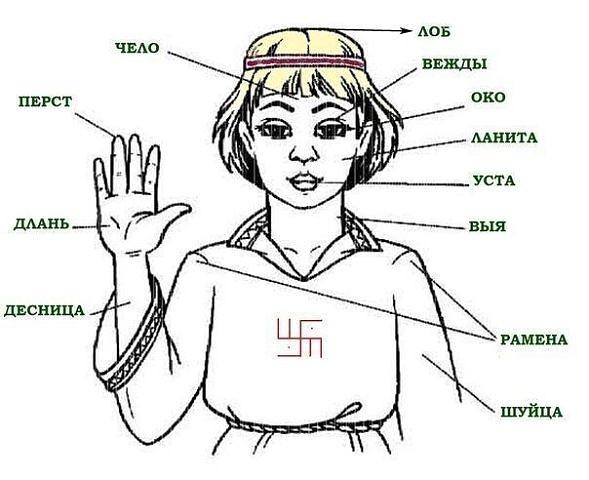627
Pyadevaya system of measures

In ancient times, the system was used Pyadevaya white peoples everywhere, after the measures of this system were given the worldly bindings and explanations, which have survived in sayings and tales of the Russian people. For example: seven genius. From the pot two inches. Peasant with nokotok. Each Merit on your yard. Miscalculated every step. On the verge of death. and t.d.Pyadevaya system of measures - a system of measures used by the ancient Slavs. It covers a range from microns to astronomical distances. For every action there is his character designation. The basis of the system laid pyadevoy average distance from the greatest to the index finger, that is, span.
Below, we present the numerical values of the basic measures of pyadevoy:
1 inch = 17 78 cm
2 inch = 1 foot (35, 56 cm)
3 inch = 1 elbow (53, 34 cm)
4 inch = 1 yard (71 to 12 cm)
5 spans = 1 step (88, 9 cm)
6 = 1 spans measure or polsazhenya (106, 68 cm)
7 = 1 spans the forehead (124, 46 cm)
8 spans = 1 column (142, 24 cm)
9 spans = 1 staff (160, 02 cm)
10 spans = 1 twisted rod (177, 8 cm)
= 1 spans 12 fathoms (213, 36 cm)
16 spans = 1 round (284, 48 cm)
17 = 1 spans oblique seven feet (302, 26 cm)
1/4 inch = 1 inch (4 cm 445)
1/16 inch = 1 nokot (1, 11125 cm)
1/256 inch (1/16 elbow) = 1 line (0 069 453 cm)
1/4096 inch (1/16 line) = 1 hair (0, 00 434 cm)
1/65536 inch (1/16 hair) = 1 hair (0 00027sm)
1 verst = 6000 spans (1066, 8 meters)
Pillar 1 = 1 mile of 517 meters
41632 1 measuring Milestone = 1000 yards (2133, 6 meters)
1 pole distance = 150 miles (227 km 6)
1 = the distance light 148021218, 5273 km
1 farthest distance = 3500 bright vistas (518,074,264,845, 5 km).
There is a saying, "No need to be a genius." Seven human growth spans equal to approximately 12 years of age.
Arshin - an old Russian measure of length equal to, in the modern-year 0 and 7112 m. The yardstick, as well, called the gauge, which is usually applied in the division vershoks.
There are different versions of the origin yardstick measure of length. Perhaps, initially, "yard" refers to the length of human steps (about seventy centimeters, while walking across the plain, at an average pace) and is the base value for other major measures determining the length of distances (seven feet, Milestone). The root "Ar" in the word yards - in the Old Russian language (and in other neighboring) means "earth", "the surface of the earth," and points out that this measure could be applied in determining the length of the path traveled by foot. There was another name for this measure - a step. Practically, the score could be done in pairs adult steps ("small" simple "fathoms", a one-two - one, one-two - two, one-two - three ...) or triples ("breech fathoms", one-two- three - one, one-two-three - the two ...), and the measurement of steps short distances, applied step by step account. Later, steel also apply, under the same name, an equal amount - arm's length.
For small measures the length of the base value was applied From ancient Rus measure - "inch» (c 17 th century - the length equal to the span named already different - "a quarter of a yard", "quarter", "chet"), from which by eye easily you could get a smaller proportion - two inches (1/2 inch) or inch (1/4 inch).
Merchants selling goods, as a rule, were measuring him with his yardstick (ruler) or a quick - measuring out 'from the shoulder. " To exclude measurement was introduced, as a reference - "bureaucratic yardstick" is a wooden ruler at the end of which the rivet ferrules with state stamp.
Step - the average length human steps = 71 cm. One of the earliest measures of length.
Span (pyadnitsa) - Russian ancient measure of length. Small span (say - "span", from the 17th century it was called - "a quarter» & lt; yard & gt;) - the distance between the ends of spaced thumb and index (or middle) finger = 17, 78 cm. Large span - the distance between the tips of the thumb and little finger (22-23 cm.). Span a somersault ("span a somersault", according to Dahl - 'span a somersault') - a span with the addition of two joints of the index Mace = 27-31 cm
The old value of our painters of icons spans measured "nine icons - seven spans (1 3/4 yard). Pure Tikhvin on gold - pyadnitsa (4 inches). Icon Georgy great deeds tetyrёh spans (in 1arshin) »
Milestone - Old Russian waypoint measure (its earlier name - field). This word originally referred to the distance traveled from one turn to the other plow during plowing. Two names for a long time were used in parallel as synonyms. There are references in written sources of the 11th century. The manuscripts of the XV century. there is an entry "field fathoms 7 hundred and 50" (length of 750 fathoms). Before Tsar Alexei Mikhailovich in 1 verst thought 1000 fathoms. When Peter the Great was equal to one mile of 500 fathoms in the modern on-year - 213, 36 X 500 = 1066, 8 m. "Mile" is also called a milepost on the road.
The value of a mile repeatedly changed depending on the number of yards that were part of it, and the amount of fathoms. Legal Code was established in 1649 "mezhevaya Milestone" in 1000 fathoms. Later, in the XVIII century, along with it was used and a "road mile" 500 fathoms ("Milestone pyatisotnaya»).
Mezhevaya Milestone - Old Russian unit of measurement equal to two miles. Miles in 1000 fathoms (2, 16 km) are widely consumed as a landmark action, usually in determining the pastures around the major cities and on the outskirts of Russia, especially in Siberia - and measure distances between settlements.
500 fathoms Milestone used less frequently, mostly for measuring distances in the European part of Russia. Long distances, especially in Eastern Siberia, determined in days away. In the XVIII century. HOAR vёrsty gradually replaced travel, and the only hole in the XIX century. Milestone is a "road" which is equal to 500 fathoms.
Old Russian measure - Sazhen.
Sazhen - one of the most common measures of length in Russia. Different purposes (and therefore value) has been more than ten yards. "Makhovaia seven feet" - the distance between the ends of the fingers widely separated hands of an adult male. "Oblique seven feet" - the longest: the distance from the toe of the left foot to the end of a raised middle finger of his right hand. It is used in the phrase: "he has an oblique seven feet at the shoulders' (in the sense - the hero, the giant) This ancient measure of length referred to Nestor in 1017 fathoms name comes from the verb syagat (overtaketh). To determine the value of old Russian fathoms played a major role discovery of stone on which was carved Slavic letters the inscription: "In the summer of 6576 (1068 YG) indiction 6 days Gleb prince ... Meryl 10,000 and 4,000 yards." A comparison of this result with the topography measurement value obtained 151 fathoms, 4 cm. With this value matched temples measurement results and the value of Russian national measures. There measuring fathoms of rope and wood "Triptych", which had the use in the measurement of distances and in construction.
According to historians and architects, it has been more than 10 yards and they had their names were incommensurable and not multiples of one another. Fathoms: a policeman - 284, 8 cm, untitled - 258, 4 cm, great - 244, 0 cm, Greek - 230, 4 cm, breech - 217, 6 cm, the royal - 197, 4 cm, the church - 186, 4 See, folk - 176 0 cm masonry - 159, 7 cm, simple - 150, 8 cm, a small - 142 4 cm and another unnamed - 134, 5 cm (data from one source), as well as - yard, pavement.
Makhovaia fathom - the distance between the ends of the middle fingers stretched arms - 1, 76 m.
Bias fathoms (make the initial "Kosovo") - 2, 48 m.
Fathoms were used before the introduction of the metric system.
Elbow stood at arm's length from the fingers to the elbow (according to other sources - "the distance in a straight line from the elbow to the end of the elongated middle finger"). The value of this ancient measure of length, according to various sources, ranged from 38 to 47 cm. Since the 16th century, gradually replaced yardstick in the 19th century and almost never used.
Elbow - originally old Russian measure of length, is already known in the 11th century. The value of ancient elbow 10.25-10.5 inches (on average about 46-47 cm) was obtained from the comparison of measurements in the Temple of Jerusalem, made abbot Daniel, and later measurements of the same size in a replica of the temple - the main temple of the New Jerusalem Monastery on the river Istra (XVII). Elbow is widely used in the trade as a particularly convenient measure. In retail canvas, cloth, canvas - has been the main measure of the elbow. In a large wholesale trade - canvas, cloth, etc., comes in the form of large cuts - "put" in length at different times and in different locations ranged from 30 to 60 cubits (in areas of trade, these measures have a specific, well-defined value) < br />
1/16 inch equaled yard, 1/4 quarter. In today's on-year - 4, 44 cm. The name "Vershok" comes from the word "top". The literature XVII. meet and share an inch - and half an inch chetvertvershki.
In determining the growth of the human or animal expense was conducted after two yards (required for normal adult): If we say that 15 inches was measured growth, it meant that he was 2 feet of 15 inches, ie 209 cm.























